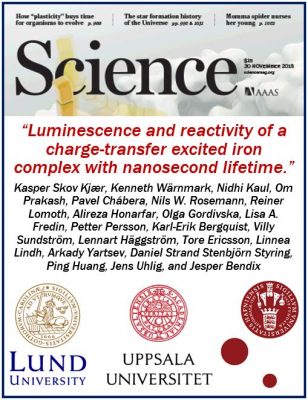Researchers succeeded in creating an iron-based molecule that could replace the rarer and more expensive metals currently used in solar power generation. The iron-based molecule can function in solar cells to produce electricity. It can also function as a photocatalyst to produce fuel.
Some solar cells and photocatalysts use technology that involves molecules containing metals. We call them ‘metal complexes.’
In this context, the task of the metal complexes is to absorb solar rays and then utilize their energy. However, the metals in these molecules are both rare and expensive. Iridium, osmium, and ruthenium, for example, are some of the noble metals that we use in solar power generation.
Kenneth Wärnmark said:
“Our results now show that by using advanced molecule design, it is possible to replace the rare metals with iron, which is common in the Earth’s crust and therefore cheap.”
Wärnmark is a Chemistry Professor at Lund University in Sweden.
Prof. Wärnmark and colleagues from the Universities of Lund and Uppsala in Sweden and the University of Copenhagen wrote about their work in the journal Science (citation below).
Solar energy
Solar energy or solar power refers to capturing the Sun’s energy and then converting it into electricity. We can then use the electricity to light up our homes, streets, and businesses. We can also use that energy to power our machines.

Iron-based molecule to replace expensive metals
Prof. Wärnmark and colleagues have spent a long time looking for an alternative to the expensive metals. They focused on trying to find an iron-based molecule. Iron is relatively easy to source, given its 6% prevalence in the Earth’s crust.
The scientists have created their own iron-based molecules. These molecules have the potential for use in solar energy applications.
In this latest study, the scientists have moved one step closer. Their new iron-based molecule can capture and utilize the energy in the Sun’s rays. It can do this long enough to react with another molecule.
The new molecule can also glow long enough to enable scientists to see iron-based light with the naked eye at room temperature. This has never happened before.
Co-author, Petter Persson, said:
“The good result depends on the fact that we have optimized the molecular structure around the iron atom.”
Persson is a Senior Lecturer of Theoretical Chemistry at Lund University.

Iron-based molecule – potential use
The authors say that their new iron-based molecule could be used in new types of photocatalysts for solar fuel production either as methanol from carbon dioxide or hydrogen through water splitting.
The molecule also has potential uses in other applications such as material in LEDs. The letters LED stand for Light Emitting Diode.
The researchers were surprised at how quickly they managed to find what they were seeking. In slightly more than five years, they managed to make iron interesting for photochemical applications with properties that are mostly as good as those of the best noble metals.
Prof. said: “We believed it would take at least ten years.”
Citation
“Luminescence and reactivity of a charge-transfer excited iron complex with nanosecond lifetime,” Kasper Skov Kjær, Kenneth Wärnmark, Nidhi Kaul, Om Prakash, Pavel Chábera, Nils W. Rosemann, Reiner Lomoth, Alireza Honarfar, Olga Gordivska, Lisa A. Fredin, Petter Persson, Karl-Erik Bergquist, Villy Sundström, Lennart Häggström, Tore Ericsson, Linnea Lindh, Arkady Yartsev, Daniel Strand Stenbjörn Styring, Ping Huang, Jens Uhlig, and Jesper Bendix. Science, 29 Nov 2018 : eaau7160. DOI: 10.1126/science.aau7160.
